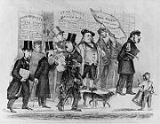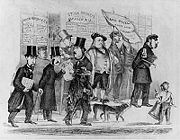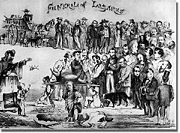
Frederick Coombs
Encyclopedia
Frederick Coombs was an eccentric who lived in San Francisco
in the 19th century and believed himself to be George Washington
. For a time he was as popular a figure as Joshua A. Norton
, the "Emperor of the United States and Protector of Mexico", and his deeds were reported in the local newspapers. He left the city after a feud with Norton who he thought was jealous of his "reputation with the fairer sex" and returned to his native New York City
.
 Little is known of his early life. He was born in New York City and was apparently a phrenologist
Little is known of his early life. He was born in New York City and was apparently a phrenologist
by trade, though he was also an accomplished photographer, daguerreotypist
, inventor and possibly a marriage broker
. He had travelled throughout the west during the 1830s giving demonstrations of phrenology, apparently accompanied by a giant
and a dwarf
, and published at least one book on the subject, Popular Phrenology in 1841 (in which the features of George Washington's skull are praised on the introductory page). He was interested in railways and designed a type of electric locomotive
that enjoyed some minor success as a curiosity but was never put into large scale production. In 1848 he visited England where he obtained some commissions for the use of his engine, and claimed to have received a proposition to supply his engine to the Russians. He spent five years in England before returning to the United States.
. Some time before 1863 he appeared in San Francisco, either claiming to be George Washington from the outset, or by other accounts, setting up his phrenology business and entertaining fashionable society with readings of their skulls. According to this second story, he was generally known as "Professor" Freddy Coombs and resembled George Washington so much that after many comments, he became convinced that he was the former President of The United States and took to dressing in uniform.
He wore a Continental Army
uniform of tanned buckskin
, and set up his headquarters at the saloon of Martin and Horton, where he would study maps while planning his campaigns for the Revolutionary War
. He was reported to have spent a winter starving himself until he was convinced by concerned friends that the Battle of Valley Forge
was over. In his office as President he composed letters to the United States Congress
and issued proclamations, just as Norton did.
During the day he would often be seen in Montgomery Street
wearing a powdered wig and tricorne hat
and carrying a banner proclaiming himself "The Great Matrimonial Candidate". Initially he, Norton and the two well-known stray dogs Bummer and Lazarus
drew equal interest from the San Francisco newspapers who delighted in recounting their exploits. Coombs appears in a couple of satirical cartoons by Edward Jump
alongside Norton and the dogs: in Ambling along Montgomery Street he appears in the centre of the picture in full uniform holding a banner with the words "And Still They Go Marching On", while in The Funeral of Lazarus he features as the gravedigger while Norton performs the ceremony.
 Although short, balding and rotund, Coombs was pompous and vain, and thought himself to be a ladies' man. He believed this formed the basis of his dispute with Emperor Norton. Norton had torn down some posters that Coombs had put up in Montgomery Street and Coombs reported him to the police. As it was not a criminal offence the police told him they could do nothing, so in an attempt to raise funds for a civil action he sold his story to the Alta California newspaper. When the reporter asked him why Norton would have done such a thing Coombs replied that he "was jealous of my reputation with the fairer sex." This caused great amusement and a few days later the Alta California published a story mocking both the men in which they reported that the "light of insanity" could be seen in Coombs eyes. Norton and Coombs, both convinced of their sanity demanded a retraction, but Norton also issued his own proclamation against Coombs in which he ordered the Chief of Police to:
Although short, balding and rotund, Coombs was pompous and vain, and thought himself to be a ladies' man. He believed this formed the basis of his dispute with Emperor Norton. Norton had torn down some posters that Coombs had put up in Montgomery Street and Coombs reported him to the police. As it was not a criminal offence the police told him they could do nothing, so in an attempt to raise funds for a civil action he sold his story to the Alta California newspaper. When the reporter asked him why Norton would have done such a thing Coombs replied that he "was jealous of my reputation with the fairer sex." This caused great amusement and a few days later the Alta California published a story mocking both the men in which they reported that the "light of insanity" could be seen in Coombs eyes. Norton and Coombs, both convinced of their sanity demanded a retraction, but Norton also issued his own proclamation against Coombs in which he ordered the Chief of Police to:
, still believing himself to be Washington and still convinced of the effect of his charms on the ladies, whom he entertained by displaying his legs on street corners. Twain reported that he travelled around New York, Philadelphia, Baltimore, and Washington selling photos of himself at Benjamin Franklin
's grave for 25 cents. When the William Penn
Mansion
in Philadelphia was proposed for demolition he asked Congress to give it to him. After it was torn down he switched to demanding the Washington Monument
.
San Francisco, California
San Francisco , officially the City and County of San Francisco, is the financial, cultural, and transportation center of the San Francisco Bay Area, a region of 7.15 million people which includes San Jose and Oakland...
in the 19th century and believed himself to be George Washington
George Washington
George Washington was the dominant military and political leader of the new United States of America from 1775 to 1799. He led the American victory over Great Britain in the American Revolutionary War as commander-in-chief of the Continental Army from 1775 to 1783, and presided over the writing of...
. For a time he was as popular a figure as Joshua A. Norton
Joshua A. Norton
Joshua Abraham Norton , the self-proclaimed Imperial Majesty Emperor Norton I, was a celebrated citizen of San Francisco, California, who in 1859 proclaimed himself "Emperor of these United States" and subsequently "Protector of Mexico".Born in England, Norton spent most of his early life in South...
, the "Emperor of the United States and Protector of Mexico", and his deeds were reported in the local newspapers. He left the city after a feud with Norton who he thought was jealous of his "reputation with the fairer sex" and returned to his native New York City
New York City
New York is the most populous city in the United States and the center of the New York Metropolitan Area, one of the most populous metropolitan areas in the world. New York exerts a significant impact upon global commerce, finance, media, art, fashion, research, technology, education, and...
.
Early life and career

Phrenology
Phrenology is a pseudoscience primarily focused on measurements of the human skull, based on the concept that the brain is the organ of the mind, and that certain brain areas have localized, specific functions or modules...
by trade, though he was also an accomplished photographer, daguerreotypist
Daguerreotype
The daguerreotype was the first commercially successful photographic process. The image is a direct positive made in the camera on a silvered copper plate....
, inventor and possibly a marriage broker
Arranged marriage
An arranged marriage is a practice in which someone other than the couple getting married makes the selection of the persons to be wed, meanwhile curtailing or avoiding the process of courtship. Such marriages had deep roots in royal and aristocratic families around the world...
. He had travelled throughout the west during the 1830s giving demonstrations of phrenology, apparently accompanied by a giant
Gigantism
Gigantism, also known as giantism , is a condition characterized by excessive growth and height significantly above average...
and a dwarf
Dwarfism
Dwarfism is short stature resulting from a medical condition. It is sometimes defined as an adult height of less than 4 feet 10 inches , although this definition is problematic because short stature in itself is not a disorder....
, and published at least one book on the subject, Popular Phrenology in 1841 (in which the features of George Washington's skull are praised on the introductory page). He was interested in railways and designed a type of electric locomotive
Locomotive
A locomotive is a railway vehicle that provides the motive power for a train. The word originates from the Latin loco – "from a place", ablative of locus, "place" + Medieval Latin motivus, "causing motion", and is a shortened form of the term locomotive engine, first used in the early 19th...
that enjoyed some minor success as a curiosity but was never put into large scale production. In 1848 he visited England where he obtained some commissions for the use of his engine, and claimed to have received a proposition to supply his engine to the Russians. He spent five years in England before returning to the United States.
San Francisco
Coombs was active as photographer in the 1850s on the West CoastWest Coast of the United States
West Coast or Pacific Coast are terms for the westernmost coastal states of the United States. The term most often refers to the states of California, Oregon, and Washington. Although not part of the contiguous United States, Alaska and Hawaii do border the Pacific Ocean but can't be included in...
. Some time before 1863 he appeared in San Francisco, either claiming to be George Washington from the outset, or by other accounts, setting up his phrenology business and entertaining fashionable society with readings of their skulls. According to this second story, he was generally known as "Professor" Freddy Coombs and resembled George Washington so much that after many comments, he became convinced that he was the former President of The United States and took to dressing in uniform.
He wore a Continental Army
Continental Army
The Continental Army was formed after the outbreak of the American Revolutionary War by the colonies that became the United States of America. Established by a resolution of the Continental Congress on June 14, 1775, it was created to coordinate the military efforts of the Thirteen Colonies in...
uniform of tanned buckskin
Buckskin (leather)
Buckskin is the soft, pliable, porous preserved hide of an animal, usually deer, moose or elk or even cowhide tanned to order, but potentially any animal's hide,. Modern leather labeled "buckskin" may be made of sheepskin tanned with modern chromate tanning chemicals and dyed to resemble real...
, and set up his headquarters at the saloon of Martin and Horton, where he would study maps while planning his campaigns for the Revolutionary War
American Revolutionary War
The American Revolutionary War , the American War of Independence, or simply the Revolutionary War, began as a war between the Kingdom of Great Britain and thirteen British colonies in North America, and ended in a global war between several European great powers.The war was the result of the...
. He was reported to have spent a winter starving himself until he was convinced by concerned friends that the Battle of Valley Forge
Valley Forge
Valley Forge in Pennsylvania was the site of the military camp of the American Continental Army over the winter of 1777–1778 in the American Revolutionary War.-History:...
was over. In his office as President he composed letters to the United States Congress
United States Congress
The United States Congress is the bicameral legislature of the federal government of the United States, consisting of the Senate and the House of Representatives. The Congress meets in the United States Capitol in Washington, D.C....
and issued proclamations, just as Norton did.
During the day he would often be seen in Montgomery Street
Montgomery Street
Montgomery Street is a north-south thoroughfare in San Francisco, California, in the United States.It runs about 16 blocks from the Telegraph Hill neighborhood south through downtown, terminating at Market Street. South of Columbus Avenue, Montgomery Street runs through the heart of San Francisco's...
wearing a powdered wig and tricorne hat
Tricorne
The tricorne or tricorn is a style of hat that was popular during the 18th century, falling out of style by 1800. At the peak of its popularity, the tricorne was worn as civilian dress and as part of military and naval uniforms...
and carrying a banner proclaiming himself "The Great Matrimonial Candidate". Initially he, Norton and the two well-known stray dogs Bummer and Lazarus
Bummer and Lazarus
Bummer and Lazarus were two stray dogs that roamed the streets of San Francisco, California, USA, in the early 1860s. Recognized for their unique bond and their prodigious rat-killing ability, they became a fixture of city newspapers, were exempted from local ordinances and immortalized in...
drew equal interest from the San Francisco newspapers who delighted in recounting their exploits. Coombs appears in a couple of satirical cartoons by Edward Jump
Edward Jump
Edward Jump , was an artist and cartoonist of the 19th century, born in Paris, France. His early life is not well documented, but he emigrated to California in 1852, attracted to the United States by the California Gold Rush....
alongside Norton and the dogs: in Ambling along Montgomery Street he appears in the centre of the picture in full uniform holding a banner with the words "And Still They Go Marching On", while in The Funeral of Lazarus he features as the gravedigger while Norton performs the ceremony.

New York
Coombs left the city immediately, presumably for New York, as in 1868 he was discovered there by Mark TwainMark Twain
Samuel Langhorne Clemens , better known by his pen name Mark Twain, was an American author and humorist...
, still believing himself to be Washington and still convinced of the effect of his charms on the ladies, whom he entertained by displaying his legs on street corners. Twain reported that he travelled around New York, Philadelphia, Baltimore, and Washington selling photos of himself at Benjamin Franklin
Benjamin Franklin
Dr. Benjamin Franklin was one of the Founding Fathers of the United States. A noted polymath, Franklin was a leading author, printer, political theorist, politician, postmaster, scientist, musician, inventor, satirist, civic activist, statesman, and diplomat...
's grave for 25 cents. When the William Penn
William Penn
William Penn was an English real estate entrepreneur, philosopher, and founder of the Province of Pennsylvania, the English North American colony and the future Commonwealth of Pennsylvania. He was an early champion of democracy and religious freedom, notable for his good relations and successful...
Mansion
Pennsbury Manor
Pennsbury Manor, an estate in Falls Township, Bucks County, Pennsylvania, was the American home of William Penn, founder and first Governor of Pennsylvania. The property was placed on the National Register of Historic Places on October 28, 1969.-History:...
in Philadelphia was proposed for demolition he asked Congress to give it to him. After it was torn down he switched to demanding the Washington Monument
Washington Monument
The Washington Monument is an obelisk near the west end of the National Mall in Washington, D.C., built to commemorate the first U.S. president, General George Washington...
.
External links
- Emperor Norton vs. George Washington the Second at Spots Unknown

